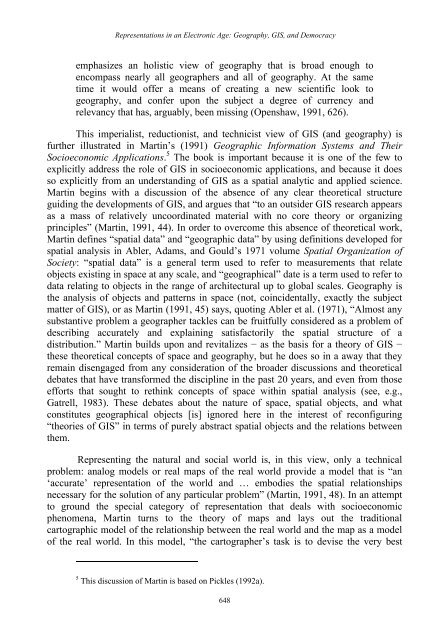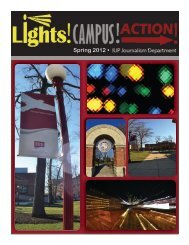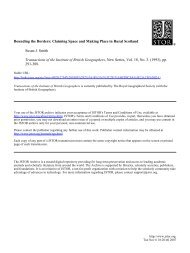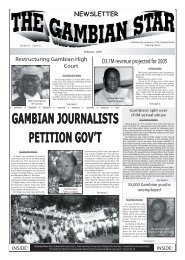Geography, GIS, and Democracy - College of Humanities and Social ...
Geography, GIS, and Democracy - College of Humanities and Social ...
Geography, GIS, and Democracy - College of Humanities and Social ...
You also want an ePaper? Increase the reach of your titles
YUMPU automatically turns print PDFs into web optimized ePapers that Google loves.
Representations in an Electronic Age: <strong>Geography</strong>, <strong>GIS</strong>, <strong>and</strong> <strong>Democracy</strong>emphasizes an holistic view <strong>of</strong> geography that is broad enough toencompass nearly all geographers <strong>and</strong> all <strong>of</strong> geography. At the sametime it would <strong>of</strong>fer a means <strong>of</strong> creating a new scientific look togeography, <strong>and</strong> confer upon the subject a degree <strong>of</strong> currency <strong>and</strong>relevancy that has, arguably, been missing (Openshaw, 1991, 626).This imperialist, reductionist, <strong>and</strong> technicist view <strong>of</strong> <strong>GIS</strong> (<strong>and</strong> geography) isfurther illustrated in Martin‟s (1991) Geographic Information Systems <strong>and</strong> TheirSocioeconomic Applications. 5 The book is important because it is one <strong>of</strong> the few toexplicitly address the role <strong>of</strong> <strong>GIS</strong> in socioeconomic applications, <strong>and</strong> because it doesso explicitly from an underst<strong>and</strong>ing <strong>of</strong> <strong>GIS</strong> as a spatial analytic <strong>and</strong> applied science.Martin begins with a discussion <strong>of</strong> the absence <strong>of</strong> any clear theoretical structureguiding the developments <strong>of</strong> <strong>GIS</strong>, <strong>and</strong> argues that “to an outsider <strong>GIS</strong> research appearsas a mass <strong>of</strong> relatively uncoordinated material with no core theory or organizingprinciples” (Martin, 1991, 44). In order to overcome this absence <strong>of</strong> theoretical work,Martin defines “spatial data” <strong>and</strong> “geographic data” by using definitions developed forspatial analysis in Abler, Adams, <strong>and</strong> Gould‟s 1971 volume Spatial Organization <strong>of</strong>Society: “spatial data” is a general term used to refer to measurements that relateobjects existing in space at any scale, <strong>and</strong> “geographical” date is a term used to refer todata relating to objects in the range <strong>of</strong> architectural up to global scales. <strong>Geography</strong> isthe analysis <strong>of</strong> objects <strong>and</strong> patterns in space (not, coincidentally, exactly the subjectmatter <strong>of</strong> <strong>GIS</strong>), or as Martin (1991, 45) says, quoting Abler et al. (1971), “Almost anysubstantive problem a geographer tackles can be fruitfully considered as a problem <strong>of</strong>describing accurately <strong>and</strong> explaining satisfactorily the spatial structure <strong>of</strong> adistribution.” Martin builds upon <strong>and</strong> revitalizes − as the basis for a theory <strong>of</strong> <strong>GIS</strong> −these theoretical concepts <strong>of</strong> space <strong>and</strong> geography, but he does so in a away that theyremain disengaged from any consideration <strong>of</strong> the broader discussions <strong>and</strong> theoreticaldebates that have transformed the discipline in the past 20 years, <strong>and</strong> even from thoseefforts that sought to rethink concepts <strong>of</strong> space within spatial analysis (see, e.g.,Gatrell, 1983). These debates about the nature <strong>of</strong> space, spatial objects, <strong>and</strong> whatconstitutes geographical objects [is] ignored here in the interest <strong>of</strong> reconfiguring“theories <strong>of</strong> <strong>GIS</strong>” in terms <strong>of</strong> purely abstract spatial objects <strong>and</strong> the relations betweenthem.Representing the natural <strong>and</strong> social world is, in this view, only a technicalproblem: analog models or real maps <strong>of</strong> the real world provide a model that is “an„accurate‟ representation <strong>of</strong> the world <strong>and</strong> … embodies the spatial relationshipsnecessary for the solution <strong>of</strong> any particular problem” (Martin, 1991, 48). In an attemptto ground the special category <strong>of</strong> representation that deals with socioeconomicphenomena, Martin turns to the theory <strong>of</strong> maps <strong>and</strong> lays out the traditionalcartographic model <strong>of</strong> the relationship between the real world <strong>and</strong> the map as a model<strong>of</strong> the real world. In this model, “the cartographer‟s task is to devise the very best5 This discussion <strong>of</strong> Martin is based on Pickles (1992a).648






